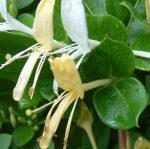J apanese honeysuckle is a deciduous to semi-evergreen perennial vine and a member of the honeysuckle family, Caprifoliaceae, that also includes snowberry, weigelia, and abelia. It is native to eastern Asia but was introduced into the US in the 1800s as an ornamental and now can be found from Maine to Florida and from Michigan and Wisconsin south to Nebraska, Kansas, Oklahoma, and Texas. The young stems may be reddish and fuzzy and become brown with exfoliating bark when mature. The vine grows up to 33′ tall and climbs by twining. The oval leaves are sometimes lobed, and are up to 3″ long. The tubular flowers have 2 reflexed lips and long stamens, and are white fading to yellow. They have a sweet vanilla scent, appear from spring until mid summer, and give way to black berries containing a few seeds. Plants spread by seed and stems that root when they touch the ground. Although the species can become invasive and choke desirable shrubs and trees, the cultivar “Hall’s Prolific’/’Halliana’ is a popular ground cover. The genus name, Lonicera, honors Adam Lonitzer (1528-1586) a German botanist and author of a popular herbal. The specific epithet, japonica, is a latinized form of Japan, a place where the plant is native.
apanese honeysuckle is a deciduous to semi-evergreen perennial vine and a member of the honeysuckle family, Caprifoliaceae, that also includes snowberry, weigelia, and abelia. It is native to eastern Asia but was introduced into the US in the 1800s as an ornamental and now can be found from Maine to Florida and from Michigan and Wisconsin south to Nebraska, Kansas, Oklahoma, and Texas. The young stems may be reddish and fuzzy and become brown with exfoliating bark when mature. The vine grows up to 33′ tall and climbs by twining. The oval leaves are sometimes lobed, and are up to 3″ long. The tubular flowers have 2 reflexed lips and long stamens, and are white fading to yellow. They have a sweet vanilla scent, appear from spring until mid summer, and give way to black berries containing a few seeds. Plants spread by seed and stems that root when they touch the ground. Although the species can become invasive and choke desirable shrubs and trees, the cultivar “Hall’s Prolific’/’Halliana’ is a popular ground cover. The genus name, Lonicera, honors Adam Lonitzer (1528-1586) a German botanist and author of a popular herbal. The specific epithet, japonica, is a latinized form of Japan, a place where the plant is native.
Type: Semi-evergreen to evergreen vine
Bloom: Two-lipped, fragrant, white flowers fading to yellow, from spring until mid summer
Size: up to 33’H x 3-6′ W
Light:Full sun to partial shade
Soil: Average, moist to dry, well-drained
Hardiness: Zones 4-9
Care: Prune back hard or mow in late winter to control grown and decrease undergrowth.
Pests and Diseases: None of significance
Propagation: Division, stem cuttings, seed
Outstanding Selections: “Hall’s Prolific’/’Halliana’